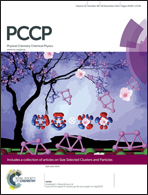Insights into the crystal-packing effects on the spin crossover of [FeII(1-bpp)]2+-based materials†
Abstract
Iron(II) complexes of the [FeII(1-bpp2)]2+ type (1-bpp = 2,6-di(pyrazol-1-yl)pyridine) have been intensively investigated in the context of crystal engineering of switchable materials because their spin-crossover (SCO) properties dramatically depend on the counterions. Here, by means of DFT + U calculations at the molecular and solid state levels we provide a rationale for the different SCO behaviour of the BF4− and ClO4− salts of the parent complex; the former features Fe(II) complexes with a regular coordination geometry and undergoes a spin transition, whereas the Fe(II) complexes of the latter adopt a distorted structure and remain in the high-spin state at all temperatures. The different SCO behaviour of both salts can be explained on the basis of a combination of thermodynamic and kinetic effects. The shape of the SCO units at high temperature is thermodynamically controlled by the intermolecular interactions between the SCO units and counterions within the crystal. The spin trapping at low temperatures in the ClO4− salt, in turn, is traced back to a kinetic effect because our calculations have revealed the existence of a more stable polymorph having SCO units in their low-spin state that feature a regular structure. From the computational point of view, it is the first time that the U parameter is fine-tuned on the basis of CASPT2 calculations, thereby enabling an accurate description of the energetics of the spin transition at both molecular and solid-state levels.
![Graphical abstract: Insights into the crystal-packing effects on the spin crossover of [FeII(1-bpp)]2+-based materials](/en/Image/Get?imageInfo.ImageType=GA&imageInfo.ImageIdentifier.ManuscriptID=C4CP03971H&imageInfo.ImageIdentifier.Year=2014)

 Please wait while we load your content...
Please wait while we load your content...